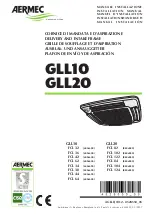
1
WATER COOLED AIR CONDITIONERS
HORIZONTAL & VERTICAL MODELS
R410A
INSTALLATION, OPERATION AND MAINTENANCE
SERIES
KACE-009A
KACE-012A
KACE-015A
KACE-018A
KACE-024A
KACE-030A
KACE-036A
KACE-042A
KACE-048A
KACE-060A
KACE-072A
KACE-096A
KACE-120A
KACE-144A
Warning
Mechanical Thermostat may affect Electronic
Control card in unit. Connect an electronic
Thermostat to unit.
Each air conditioner has been operated and checked out
prior to shipment. Failure to operate after installation
indicates damage in transit or improper installation.
INSPECTION
Check packaging during unloading. Note transit damage on
all copies of bill of lading. Inspect air conditioners for hidden
shipping damage after packaging is removed. Transit
damage claims must be filed promptly with Freight
Company by purchaser.
HANDLING
Always handle
Vertical units upright and Horizontal
units flat on their base
. Moving a vertical unit on its side,
placing a horizontal unit on end, or dropping it may damage
internal parts and displace oil from the compressor's
crankcase.
STORAGE
If job site storage is necessary, place the unit in a clean,
warm dry area. Follow instructions under Handling.
LOCATION
Note that units with different capacities may have identical
dimensions. Labels on unit packaging must be carefully
scrutinized and matched to job location. These units are not
approved for outdoor installation and therefore must be
installed inside the space being conditioned.
PLACEMENT
Install air conditioners in a level plane and locate unit
around the service panel to ensure that proper access is
available including that for filter removal.
¨
For Vertical Units: Install the air conditioner with a piece of
sound insulating material between unit and floor to avoid
possible transmission of noise into the building structure.
(rubber backed carpeting will suffice for vertical models).
For units installed in closets adjacent to conditioned space,
provide insulated return air ducting with at least one 90
o
elbow or provide a sound baffle between the return air grille
and unit filter.
¨
Horizontal units are provided with isolation hanger
support. See Fig. 2 for proper installation when the unit is
suspended.
LOCATION OF SUPPLY & RETURN CONNECTIONS
(SEE FIG. 1 & 2)
WIRING
All wiring should conform to the CEC and/or local code
requirements. Power disconnect shall be field provided (by
others). The wiring diagram is located on electrical box
cover on vertical models and on the back of the service
panel on horizontal models. Make certain the line voltage
and the 24 volt control circuit are properly identified and
wired in accordance with the unit wiring diagram.
¨
Water cooled air conditioners are classified as direct
(permanently) connected devices by the CEC. Air
conditioners must be properly grounded as per instructions
on the unit wiring diagram.
CONDENSATE DRAINAGE
Vertical Units
: Ensure that the plastic drain tube is
connected to the bottom of the coil drain pan at one end
and the other end of the condensate drain tube should
extend through the left post on the front side of the unit, see
Fig. 1. Connect the drain through a trap to the condensate
drain system in conformance to local plumbing codes.
Slope the drain line for proper gravity flow of condensate
away from unit. The top of the trap and further connections
must be below the unit drain connection level.
Horizontal Units:
The condensate drain tube should be
connected to the side of the unit, see Fig. 2. Follow the
above instructions (given for the vertical units) for proper
condensate draining.
WATER SUPPLY (UNIT CONNECTED ON OPEN WATER
CIRCUIT)
The source of water for air conditioner operation is the
responsibility of the owner and/or the installing contractor.
The air conditioner
must not function without water
, and
predetermined rates of flow (l/s or USGPM) must be
maintained for the unit to opera-te at rated capacity. Since
the water function is to absorb heat from the refrigerant, the
flow rate for each model varies with the entering water
temperature (EWT). A pressure-operated water valve is
installed for this reason inside the unit and SAE-13 calibra-



























